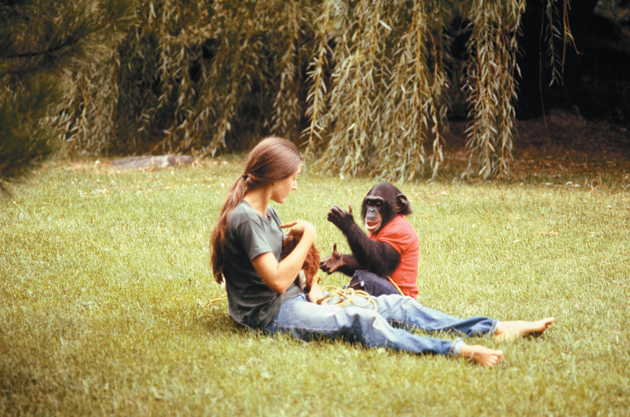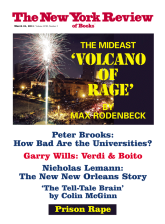It has been argued that a monkey banging away randomly at a typewriter long enough would eventually produce the complete works of Shakespeare. Of course, it’s entirely possible that he would first come up with Pierre Boulle’s 1963 pulp classic Planet of the Apes, and perhaps pause to scratch his forehead over this monologue by an interstellar human explorer:
Of what is our literature made? Masterpieces?… No. But once an original book has been written—and no more than one or two appear in a century—men of letters imitate it, that’s to say they copy it so that hundreds of thousands of books are published on exactly the same theme, with slightly different titles and modified phraseology. This should be able to be achieved by monkeys, who are essentially imitators, provided of course they are able to make use of language.
That provision is a big one, as anybody who wades into the contentious field of animal language research soon discovers. But this hasn’t stopped talking apes from becoming a staple of modern literature, from Kafka’s “Report to an Academy,” delivered by a distinguished captive ape named Rotpeter, to Sara Gruen’s recent best-seller Ape House, a screwball riff on bonobo language research and reality TV. Then again, you could also say that talking apes define literature. From the Bible to The Da Vinci Code, what is the Western canon but the grandiloquent, self-obsessed babblings of puffed-up hairless primates?
Or so might argue Bruno Littlemore, the narrator and hero of Benjamin Hale’s ambitious first novel. Bruno is the son of Rotpeter—only in this case, the name belongs not to Kafka’s tuxedo-wearing, wine-sipping melancholic but to the star attraction at Chicago’s Lincoln Park Zoo, a brutish captive who entertains visitors by cadging cigarettes and raping the occasional frog. Bruno, a more sensitive type, is whisked away at age two to a lab at the University of Chicago, where his unusual intelligence earns him a spot in a controversial language experiment. The results are eventually published in the journal Nature, under the title “The BRUNO Project”—short for “Behavioral Rearing into Ultroneous Nounenal Ontogensis.” The Evolution of Bruno Littlemore is Bruno’s own bitter, boastful, bombastic, and no less ponderously intellectual riposte, dictated some twenty-five years later from a sanctuary where he has been imprisoned for murder.
Bruno is an American ape, Chicago born—and if you don’t hear the affinity between this “first-generation immigrant to the human species” and Augie March, Alexander Portnoy, and all the other lusty, fast-talking strivers of postwar American literature, then you haven’t spent as much time in the libraries of Hyde Park as he has. Bruno has the autodidact’s fondness for the ostentatious literary reference, and never simply suffers insomnia when the “red-eyed monster of sleeplessness” can drive Hypnos from his bed. In the first forty pages alone, we get references to Thoreau, Freud, Cézanne, Woyzeck, Kafka, and Artaud. When a researcher dangles a Prufrockian peach as reward in a scientific experiment, you can be sure that Bruno will dare to eat his allusion and have it too.
If the biblical metaphor of forbidden fruit fails to also come to mind, Bruno quotes passages of Paradise Lost to drive the point home. He reads Milton’s poem and falls in love with the Devil and his “bourgeois fantasy” of “self-authorship.” (Yes, Bruno has also read the Marxist critic Terry Eagleton.) “Like Satan,” he declares, “I made myself with words.”
But if most of the human beings he meets turn out to be far less than angels, Bruno is not convincingly of the devil’s party. He may boast of being “inwardly consumed with a fierce, insane, insatiable lust that was always rushing and crackling its way through my soul like a match held to a pile of dry straw,” but his taste for “sapiens sapienettes” is pretty much limited to Lydia Littlemore, the attractive young primatologist who takes him home and ultimately takes him into her bed. At one point, when Bruno finds himself hiding under the covers with an underage beauty queen, he covets only her algebra homework. So much for the comparisons to Humbert Humbert this flamboyantly immoral wordaholic seems to be courting.
Which isn’t to say the sex scenes with Lydia won’t shock the bourgeoisie, or at least some corners of it: in early February, Hale’s publisher sent out a press release noting, with satisfaction verging on relief, that the book’s “positive depictions of bestiality” had been denounced in the conservative religious journal First Things (though one can’t help thinking that Hale would have gotten a far more impressive haul of publicity if his interspecies transgressions had involved, say, talking dogs). Even hardened libertines may find themselves flinching a bit—and not just at sentences like “I, Bruno the incubus, continue to lap at her yonic mollusk.” As Bruno points out, the real taboo he’s violating isn’t bestiality, but incest. Lydia, who raised him on Sesame Street and the Montessori method, doesn’t sit too far away on the Great Chain of Being, but too close on the family tree. Not that the religious zealots who all too predictably gather outside her apartment seem to have made that fine distinction. “Why did these people hate us?” Bruno asks. “Because they, being good Christians, did not believe in evolution” and “because there, swimming in a pouch of fluid in Lydia’s lower abdomen, was living, unassailable proof of human evolution.”
Advertisement
But Lydia’s pregnancy is less proof of evolution than the kind of miracle only possible in fiction, where an author-god can shape the world according to his own intelligent design. Bruno’s god is a highly didactic god, if not always a certain one. On the whole, Hale—who has clearly read his Chomsky and his Skinner, and knows his Clever Hans (the late-nineteenth-century horse whose apparent ability to count turned out to be a byproduct of unconscious cuing by his trainers) from his Nim Chimpsky (a baby chimp “cross-fostered” by a human family in a famous failed experiment in the 1970s)—seems unsure how much of how own design he wants to explain to the reader.
We get lots of gnomic pronouncements about the nature of language: it is a “criminal approximation,” a “lie,” and effort to “gild the chaos of the universe with our symbols.” But ultimately such musings fail to distract from more basic questions. Would Bruno really be able to call up vivid memories from the time before he had language? How much language would he need to have learned before he could remember his dreams? Would language reveal ape consciousness to be so exactly like human consciousness? Why do the few snippets of Bruno’s actual speech we hear sound so lifeless?
And just how does Bruno learn language anyway? The full flowering supposedly happens only after he and Lydia have escaped the lab at Chicago, run by a cold-hearted behaviorist skeptic in the Skinner mode, and settled into an edenic Colorado ranch. There Bruno is given free run of the well-stocked library and freed from experiments of all kinds (if not from the rigors of hot-tub orgies). We get accounts of his lessons in logic and philosophy, but ultimately hear more about his body-shaving and back-alley nose job than about his “water pump moment,” as he dismissively calls it. “Describing the process of learning to speak is like trying to bite your own teeth,” he declares, with uncharacteristic incisiveness. “We do not demand that human memoirists first explain how they became capable of language before getting down to the business of telling their stories.” Except that, in this case, the fact that the memoirist became capable of language pretty much is the story, and Hale’s decision to bury it in page after page of bloated reflection and often sketchily narrated picaresque adventure feels like an evasion.
“You have had the cruel misfortune to join humanity at a time when most people no longer care about the question of what it means be to be human,” Bruno is informed by Leon Smoler, a grandiloquent small-time actor he befriends in the New York subway after he is forcibly separated from Lydia and sent east. But Hale’s novel often seems more interested in the abstract notion of “humanity” than in actual Homo sapiens. For all his hard-won book-learning, Bruno lacks what his scientist-keepers would call a theory of mind—the ability to imagine himself into someone else’s head, and recognize that they have knowledge and desires different from his own.
Lydia in particular comes off as little more than a prop in Hale’s own fictional experiment, stimulus and reward all wrapped up in one convenient package. If Bruno struggles to find the words to describe their orgasms, Lydia seems happy with ecstatic and strangely unconflicted moans. At one point, Bruno learns that she had previously been married and had a stillborn child, a trauma barely paused over except, perhaps, to allow the reader to register the parallel with his own estrangement from his family. When Lydia develops a brain tumor and loses her capacity for language, it feels less like a tragic irony than a heavy-handed crank of the thematic machinery.
Hale often writes beautifully, sending some startlingly vivid images blazing through the thickening fog of pseudophilosophy. There is the pervasive sense of an interesting mind lurking behind Bruno’s ultimately rather conventional one. If Bruno too often seems to just be aping the themes of the literature he’s gorged on, he’d like us to believe the fault lies not with his human creator but with language itself. “Language is an inner death of that sense of perpetual amazement at the ever-renewed world,” he says. “We gain language and lose the amazement.” Next time around, maybe this talented novelist will manage to keep better hold of both.
Advertisement
This Issue
March 24, 2011




